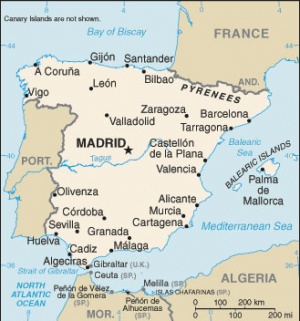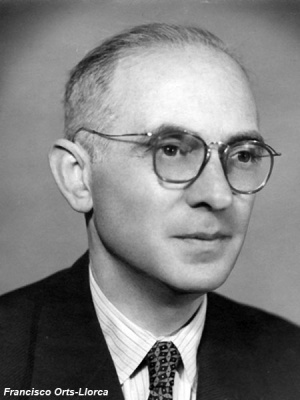Spain Statistics
Introduction
This page links to the current online resources available to explore Spanish population and birth data.
La página de traducir Español | La página de catalán traducir
| Statistics Links: Introduction | Reports | World Population | World Fertility | World Infant Mortality | Maternal Mortality | Australia | Brazil | Canada | China | Germany | India | Indonesia | Europe | Myanmar | Netherlands | Spain | United Kingdom | Romania | Uganda | United States | BGD Tutorial - Applied Embryology and Teratology | National Perinatal Statistics Unit | AIHW | Category:Statistics | |
|
Embryology
Madrid Collection - The human embryo histology collection was started in 1935 by Professor Orts-Llorca (1905-1993) and is located at the Embryology Institute of Complutense University of Madrid.
<pubmed>19924623</pubmed>| Int J Dev Biol.
- "Francisco Ort-Llorca (1905-1993) was one of the most outstanding Spanish embryologists of the XX century. He was disciple of Henri Rouvire in Paris (France), Alfred Fischel in Vienna (Austria), Walther Vogt in Munich (Germany) and Pedro Ara in Madrid (Spain). From 1935, he was professor of Human Anatomy at the Faculty of Medicine of Cadiz, belonged then to the University of Seville (accidentally, in the University of Valencia, during the Spanish Civil War from 1936-1939) and, later on, at the Faculty of Medicine of Madrid (Complutense University) from 1954 to 1975. He was internationally recognized in anatomical sciences and stood out for his contributions to descriptive and experimental Embryology and Teratology, particularly in those aspects connected to the normal and pathological development of the heart and visual organs."
Prof Jose Francisco Rodriguez Vazquez
Current Professor and Chair of Human Anatomy and Embryology,
Faculty of Medicine of the Complutense University.
- Links: Madrid Collection
Assisted Reproductive Technology
<pubmed>19460223</pubmed>| Camb Q Healthc Ethics.
- "It might come as a surprise to many that Spain, a country with a strong Catholic tradition that officially banned contraceptive technologies until 1978, has some of the most liberal regulations in assisted reproduction in the world. Law No. 35/1988 was one of the first and most detailed acts of legislation undertaken on the subject of assisted-conception procedures. Indeed, not only did the law permit research on nonviable embryos, it made assisted reproductive technologies available to any woman, whether married or not, through the national healthcare system."
General Statistics
- Population: 47,737,941 (July 2014 est.)
- country comparison to the world: 29
Age structure
- 0-14 years: 15.4% (male 3,791,781/female 3,575,157)
- 15-24 years: 9.6% (male 2,370,289/female 2,212,511)
- 25-54 years: 45.9% (male 11,158,451/female 10,752,197)
- 55-64 years: 11.4% (male 2,662,055/female 2,799,379)
- 65 years and over: 17.5% (male 3,582,643/female 4,833,478) (2014 est.)
Median age
- total: 41.6 years
- male: 40.4 years
- female: 42.9 years (2014 est.)
Population growth rate
- 0.81% (2014 est.)
- country comparison to the world: 135
Birth rate
- 9.88 births/1,000 population (2014 est.)
- country comparison to the world: 197
Death rate
- 9 deaths/1,000 population (2014 est.)
- country comparison to the world: 58
Sex ratio
- at birth: 1.07 male(s)/female
- 0-14 years: 1.06 male(s)/female
- 15-24 years: 1.07 male(s)/female
- 25-54 years: 1.04 male(s)/female
- 55-64 years: 0.98 male(s)/female
- 65 years and over: 0.74 male(s)/female
- total population: 0.97 male(s)/female (2014 est.)
Mother's
- Mean age at first birth: 29.8 (2010 est.)
- Maternal mortality rate: 6 deaths/100,000 live births (2010) country comparison to the world: 170
- Total fertility rate: 1.48 children born/woman (2014 est.)
Infant mortality rate
- total: 3.54 deaths/1,000 live births
- country comparison to the world: 208
- male: 3.84 deaths/1,000 live births
- female: 3.21 deaths/1,000 live births (2011 est.)
Life expectancy at birth
- total population: 81.47 years
- country comparison to the world: 18
- male: 78.47 years
- female: 84.67 years (2014 est.)
HIV/AIDS
- 130,000 (2009 est.)
- country comparison to the world: 38
Ethnic groups
- composite of Mediterranean and Nordic types
Data: The World Factbook Spain
External Links
External Links Notice - The dynamic nature of the internet may mean that some of these listed links may no longer function. If the link no longer works search the web with the link text or name. Links to any external commercial sites are provided for information purposes only and should never be considered an endorsement. UNSW Embryology is provided as an educational resource with no clinical information or commercial affiliation.
- Spanish Statistical Office Nacional de Estadistica
- The World Factbook Spain
Glossary Links
- Glossary: A | B | C | D | E | F | G | H | I | J | K | L | M | N | O | P | Q | R | S | T | U | V | W | X | Y | Z | Numbers | Symbols | Term Link
Cite this page: Hill, M.A. (2024, April 26) Embryology Spain Statistics. Retrieved from https://embryology.med.unsw.edu.au/embryology/index.php/Spain_Statistics
- © Dr Mark Hill 2024, UNSW Embryology ISBN: 978 0 7334 2609 4 - UNSW CRICOS Provider Code No. 00098G


